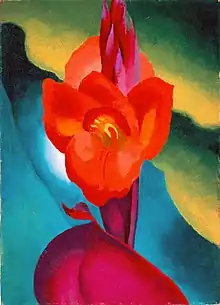Flower paintings of Georgia O'Keeffe
The American artist Georgia O'Keeffe is best known for her close-up, or large-scale flower paintings,[1] which she painted from the mid-1920s through the 1950s.[2] She made about 200 paintings of flowers of the more than 2,000 paintings that she made over her career.[3] One of her paintings, Jimson Weed, sold for $44.4 million, making it the most expensive painting sold of a female artist's work as of 2014.[1]

Background

O'Keeffe experimented with depicting flowers in her high school art class. Her teacher explained how important it was to examine the flower before drawing it. So, O'Keeffe held it in different ways, capturing different perspectives of the flowers, and also created studies of only a portion of the flower. During this process she also drew the flower simpler with each iteration.[4]
After she had been painting for a few years, she became discouraged, and when she began painting again, she remembered the technique she had learned earlier to see things in a different way.[4]
Influenced by photography
By the mid-1920s, O'Keeffe began making large-scale paintings of natural forms at close range, as if seen through a magnifying lens.[5] O'Keeffe learned modernist photography techniques, like close-cropping from, Paul Strand, and others.[2] Strand was particularly influential in her development of cropped, close-up images. She received unprecedented acceptance as a female artist from the fine art world due to her powerful graphic images.[6] Depictions of small flowers that fill the canvas suggest the immensity of nature and encourage viewers to looks at flowers differently.[2]
Examples of some of her close-up images of flowers include Oriental Poppies,[5][8] several Red Canna paintings,[9] and what has been described as her first large-scale flower painting, Petunia No. 2 (1924).[10]
Composition and design
In 1928, Time magazine wrote of her paintings, "when Georgia O'Keeffe paints flowers, she does not paint fifty flowers stuffed into a dish. On most of her canvases there appeared one gigantic bloom, its huge feathery petals furled into some astonishing pattern of color and shade and line."[11]
Symbolism
Works such as Black Iris III (1926) evoke a veiled representation of female genitalia while also accurately depicting the center of an iris.[12] Alfred Stieglitz, O'Keeffe's husband who promoted her works of art, first espoused the theory that the paintings represented a woman's vulva in the 1920s.[1][13] Tanya Barson, curator at Tate Modern, stated that male art critics perpetuated this assertion.[1] O'Keeffe consistently and vigorously denied the validity of Freudian interpretations of her art.[1][13]
—Georgia O'Keeffe, In a letter to Mabel Dodge Luhan, in 1925[14]
O'Keeffe, whose comfort with her sexuality is evident in the nude photographs taken of her by her husband Alfred Stieglitz, was not comfortable with the way that the paintings were interpreted as erotic images. This may have more to do with the degrading ways that the paintings were discussed. Stieglitz marketed her flower paintings in sexual terms, including quotes from men who were influenced by Stieglitz's viewpoints.[14] She asked her friend, Mabel Dodge Luhan, to write of her work from a feminine perspective to counter interpretations by men.[14]
Judy Chicago gave O'Keeffe a prominent place in her The Dinner Party (1979) in recognition of what many prominent feminist artists considered groundbreaking introduction of sensual and feminist imagery in her works of art,[12] seeing it as a sign of female empowerment.[1]
Beginning July 2016, Tate Modern conducted a retrospective of more than 100 of O'Keeffe's work, in part to provide additional views to the theory that her paintings are depictions of female genitalia.[1]
References
- Hannah Ellis-Petersen (March 1, 2016). "Flowers or vaginas? Georgia O'Keeffe Tate show to challenge sexual cliches". Guardian. Retrieved January 18, 2016.
- "Flower Abstraction". Whitney Museum of American Art. Retrieved January 18, 2017.
- Kristy Puchko (April 21, 2015). "15 Things You Should Know About Georgia O'Keeffe". Mental Floss. Retrieved January 18, 2017.
- "Georgia O'Keeffe". Educational Insights, Smithsonian American Art Museum. Archived from the original on June 29, 2012. Retrieved January 18, 2017.
- Liese Spencer (December 31, 2015). "From Georgia O'Keeffe to War and Peace: unmissable arts events in 2016". The Guardian. Retrieved January 18, 2017.
- Hunter Drohojowska-Philp (November 17, 2005). Full Bloom: The Art and Life of Georgia O'Keeffe. W. W. Norton. pp. 4–5. ISBN 978-0-393-32741-0.
-

- Laura Cumming (April 7, 2012). "The 10 best flower paintings – in pictures". The Guardian. Retrieved January 18, 2017.
- Barbara Buhler Lynes; Jonathan Weinberg; Georgia O'Keeffe Museum (9 March 2011). Shared Intelligence: American Painting and the Photograph. Univ of California Press. p. 92. ISBN 978-0-520-26906-4.
- Biography.com Editors (August 26, 2016). "Georgia O'Keeffe". Biography Channel. A&E Television Networks. Retrieved January 18, 2017.
- Sarah Begley (November 21, 2014). "Georgia O'Keeffe Sets New Auction Record for Women Artists". Time. Retrieved January 18, 2017.
- Georgia O'Keeffe Place Setting, Brooklyn Museum, retrieved January 18, 2015.
- "Georgia O'Keeffe, Female candidates for Conservative leadership, Emma Straub". BBC. July 5, 2016. Retrieved January 18, 2017.
- Marianne Doezema; Elizabeth Milroy (1998). Reading American Art. Yale University Press. pp. 359–360. ISBN 978-0-300-06998-3.